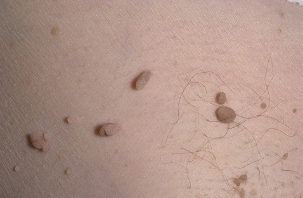Papilloma is a lesion on the skin and mucous membranes caused by the human papillomavirus virus.
Causing agent - virus of the genus Papilloma. Currently, more than 60 variants are known, 32 of which are recognized as causes of disease.
Transmission pathways - contact (through skin microtrauma), genitals, perinatal (during childbirth).Manifestation of papilloma

- Papilloma of the skin (warts).
Often observed on the hands, more rarely on other parts of the body. Local lesions occur in children and adolescents. In patients with immunocompromising, wart lesions can be widespread. The incubation period is 1-6 months. The maximum viral content of the affected tissue was recorded 6 months after infection. - Vinegar papilloma (moderate).
Their causative agent is human papillomavirus (HPV). This shape is indicated by hard bruises with rough surfaces of 1 mm or more in diameter, with a tendency to merge. Vulgar papilloma often covers a large area. They can appear anywhere, but more often located on the back of the palms and fingers, in children - on the knees. A single papilloma can exist for months or even years, practically unchanged, but a rapid spread of the process is also possible. There are isolated cases of papilloma degeneration into tumors. Immunodeficiency conditions contribute to the spread of the process. - Plantar Papilloma.
The causative agents are HPV-1 (inner form), HPV-2 (mosaic wart) and HPV-4 (small wound). The process begins with the appearance of small, shiny bumps, acquiring the characteristics of a special papilloma, surrounded by prominent rims. Occasionally, around one papilloma, many female formations appear, resembling bubbles - mosaic warts.
Plantar papilloma can be painful and difficult to walk. The period of their existence is different. In some cases, especially in children, spontaneous loss of a number of papillomas is possible. This form of the disease is often confused with clots that appear at the site of pressure on the fingers or between the fingers. Corn, unlike papilloma, has a smooth surface with a skin pattern. - Flat papilloma.
Their causative agents are HPV-3 and HPV-10. They are represented by fine bruises of normal skin color (light yellow or slightly colored). They can be round or polygonal. The appearance of flat papilloma, especially in children, is usually accompanied by itching, inflammation of the affected area, redness, pain. - Papilloma filiform.
They are found in 50% of the population over the age of 50 more often in the armpits, in the groin, in the neck, around the eyes. The process begins with the appearance of small yellowish or slightly colored cones, then grows and turns into a dense elastic formation extending to 5-6 mm in size. In places where there may be trauma, papillomas can become inflamed. Their spontaneous loss did not occur. - Local epithelial hyperplasia (Beck disease).
The causative agent is human papillomavirus 13 and 32. The disease was first described in American Indians. Observed on the mucous membranes of the mouth, tongue, lips in the form of small combined papillary. - Genital warts.
The causative agents of genital warts are human papilloma viruses with low (6, 11), moderate (31, 33, 35) and high risk (16, 18). The virus is sexually transmitted. The incubation period lasts from a few weeks to months. In some cases, lesions are minimal, often unnoticed. Infected cells are prone to malignant degeneration. In most cases, a long and extensive process accompanies immune deficiency.
Cervical cancer is most commonly diagnosed in women with genital warts. In most cases, regardless of the patient's age, the viral genome is detected by DNA hybridization. The causative agent is HPV-18. - Papillomatosis of the larynx.
The causative agents are HPV-6 and HPV-11. They are rarely registered. In most cases, papillomatosis is detected in children under 5 years of age who are infected in the maternal birth canal. The appearance of characteristic growths on the vocal cords is observed, which causes difficulty speaking and disruption of air circulation in the upper respiratory tract.
Papilloma treatment
The same symptoms can be a sign of a different disease, and the disease may not continue according to the textbook. Do not try to cure yourself - see a doctor.
Currently, there are no consolidated international standards for the treatment of papilloma. Official treatment guidelines so far include
- cytostatic (antineoplastic drug),
- laser cryo,
- electro destruction.
But it is not always effective and is accompanied by relapse.
Other treatments for papilloma:
- For skin papilloma and vulgar (moderate) - surgical removal (cryodestruction, laser removal in combination with immune correction).
- For plantar - cryodestruction, laser and / or diathermocoagulation.
- Mosaic papilloma is the most difficult to treat. When they disappear, especially in children, signs of inflammation are observed.
- For flat form - cryotherapy with immunity correction.
- For filiform - diathermocoagulation.
- For local epithelial hyperplasia, cryotherapy with immune correction.
- If there is cutaneous dysplasia, cryotherapy or diathermocoagulation with subsequent immunity correction.
- In genital warts - removal of warts with cryo therapy, laser excision or diathermocoagulation and mandatory correction of the immune system.
Treatment of genital papilloma can be difficult with other genital infections (chlamydia, bacterial vaginosis, herpes, CMV infection, etc. ). In this case, the treatment is carried out in parallel.














































































